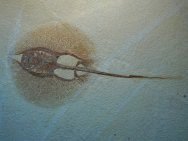Heliobatis radians
Class Chondrichthyes, Subclass Elasmobranchii, Superorder Batoidea, Order Rajiformes Family Dasyatidae
Geological Time: Eocene
Size: Heliobatis fossil fish is 278 mm in length, 138 mm across
Fossil Site: Green River Formation, Fossil Lake, Kemmerer, Wyoming
|
This
is an exquisite, museum quality female Stingray specimen known
as Heliobatis radians (Order: Rajiformes; Family: Dasyatidae),
and the only species of ray from the Green River Formation that
was known up until 2004 when Carvalho et al. (2004) described
Asterotrygon Rays belong to the Chondrichtyes, as do the sharks. All have an inner skeleton made of cartilage. Since cartilage comprises more organic material (collagen and elastic tissues) than bone, it decays more rapidly. As a result, fossils of cartilaginous fishes generally are rare. The cartilaginous fishes appeared in Silurian time, and their ancestors remain one of the most successful groups of marine animals. It is accompanied by traces of a bony fish, most likely a Diplomystus dentatus near the edge of the plaque, making for a wonderful contrast between one of the most rare and most common fish found in Green River deposits. Diplomystus has the body form and mouth placement of a surface feeder, and is thought to have been a predator of smaller surface-feeders such as Knightia. Reference: Carvalho, M.R.; Maisey, J.G.; Grande, L. (2004). "Freshwater stingrays of the Green River Formation of Wyoming (early Eocene), with the description of a new genus and species and an analysis of its phylogenetic relationships (Chondrichthyes, Myliobatiformes).". Bulletin of the American Museum of Natural History 284: 1–136. Attribution: Stone Relic CC BY-NC 4.0 Also see: Class Chondrichthyes Fossils Museum and Rare Fish Fossils |











